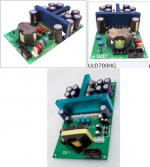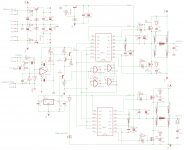Have anything stumbled across this module before
https://www.alibaba.com/product-detail/Power-Amplifier-module-High-Efficiency-Power_60467993614.html
It have good specs and have some similarities ti Hypex UcD - at least visual similarities, and the outputfilter also seems to be the same type.
https://www.alibaba.com/product-detail/Power-Amplifier-module-High-Efficiency-Power_60467993614.html
It have good specs and have some similarities ti Hypex UcD - at least visual similarities, and the outputfilter also seems to be the same type.
I contacted Hypex and forwarded the link.
Seems to happen more often.
Good example of intellectual robbery.
Seems to happen more often.
Good example of intellectual robbery.
The heatsink and it's location looks similar .Other parts don't seem to have the same location especially the capacitors. Wonder if the circuit is a carbon copy or just based on the original UcD. With what we can see now does it qualify for being a fake or a duplicate ?
It was not my intention to accuse the vendor for copying. Just to hear if anyone knew it. If its a copy and violating intellectual property, then it's not ok.
The fact that they copied the original Hypex datasheet is enough evidence that it's about a copy. Shamefull.
There is the possibility that the specs are just a copy and aren't actually met. Does anyone know ?
Then there a lot of other things. Reliability, temp rise, efficiency, distortion performance over frequency and output etc.
Wonder if anyone verified all this. Is the HF response really independent of the load ?
If any off this is off it may not be a direct copy. Certainly looks VERY close !
Then there a lot of other things. Reliability, temp rise, efficiency, distortion performance over frequency and output etc.
Wonder if anyone verified all this. Is the HF response really independent of the load ?
If any off this is off it may not be a direct copy. Certainly looks VERY close !
Last edited:
Well some of us like the idea Alibaba now can be sued in New York, I believe several companies already started. Better chance than Chinese court I would think.
Philips owns the Ucd patent and allows anyone to use it if they do it with some Philips parts. Or at least that's how it used to be.
Edit: hmm, no mention of that on the nxp (previously Philips) website. They may have changed their policy?
Edit: hmm, no mention of that on the nxp (previously Philips) website. They may have changed their policy?
Last edited:
bwaslo said: Philips owns the Ucd patent and allows anyone to use it if they do it with some Philips parts. Or at least that's how it used to be.
Edit: hmm, no mention of that on the nxp (previously Philips) website. They may have changed their policy?
I say:
I suspect the chinese can copy anything and get away with it, especially in their home market. Their only goal is profit, legality is a nuisance to be ignored.
I can see ways to sidestep the Philips UCD patent. It's a narrow patent. It does not cover bridged amps, for example. It does not cover using a comparator instead of an amplifier at input. You could say they are an obvious extension, but then I could say the Philips patent is obvious too. Just a silly oscillator with AM modulation thrown in. Any radio amateur could have built it years ago.
I of course would never take on a giant Philips, but a big player could using variations like I listed. Full employment for lawyers, that's the outcome.
For instance, does the following bridged design infringe? It uses a bridged output, the and the opposite phase is not in the feedback loop. Those are major differences. This design is hereby in public domain, haha.
Edit: hmm, no mention of that on the nxp (previously Philips) website. They may have changed their policy?
I say:
I suspect the chinese can copy anything and get away with it, especially in their home market. Their only goal is profit, legality is a nuisance to be ignored.
I can see ways to sidestep the Philips UCD patent. It's a narrow patent. It does not cover bridged amps, for example. It does not cover using a comparator instead of an amplifier at input. You could say they are an obvious extension, but then I could say the Philips patent is obvious too. Just a silly oscillator with AM modulation thrown in. Any radio amateur could have built it years ago.
I of course would never take on a giant Philips, but a big player could using variations like I listed. Full employment for lawyers, that's the outcome.
For instance, does the following bridged design infringe? It uses a bridged output, the and the opposite phase is not in the feedback loop. Those are major differences. This design is hereby in public domain, haha.
Attachments
Last edited:
Lego took Lepin in Chinese court and lost
The trial Lego versus Lepin has not even begun !
I can see ways to sidestep the Philips UCD patent. It's a narrow patent. It does not cover bridged amps, for example.
In contrary, it is a very broad patent. The logic behind patent claims: The less feature is specified the more case it covers. No need for mentioning bridge or any specific parts over the extreme minimum. Every derivatives are included in the main claims. Additive protection can be achieved by specifying sub-claims, but it is not really neccessary.
The main claims covers any self-oscillating ClassD amp that contains post-filter feedback, and (essentially) free of hysteresis. No specialisation, combination or additional circuitry can discard the infringement if the main claims are fulfilled.
It does not cover using a comparator instead of an amplifier at input.
Comparator is a differential amplifier. No need for mentioning this in a patent.
You could say they are an obvious extension, but then I could say the Philips patent is obvious too.
Nothing is obvious unless it is written somewhere, or there is any other way to convince the court when you attack the patent... Extension is not exclusion.
Just a silly oscillator with AM modulation thrown in. Any radio amateur could have built it years ago.
Saying silly doesnt tell anything about UcD.
Did they? Show documents!
But it is absolutely not an AM modulator. If you think there is any relevant common feature with an AM modulator, then you don't understand anything about UcD.
For instance, does the following bridged design infringe? It uses a bridged output, the and the opposite phase is not in the feedback loop. Those are major differences. This design is hereby in public domain, haha.
You shouldnt search for difference from the schematic, which is only an intentionally simplified example. You must search for differences from the claims. If the claims are not fulfiled, then no infringement. Otherwise yes.
- Status
- Not open for further replies.
- Home
- Amplifiers
- Class D
- New class D from China - UcD?


